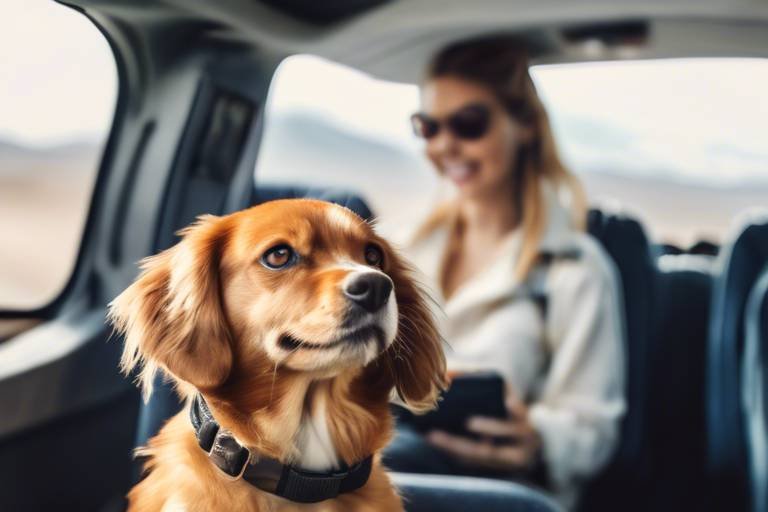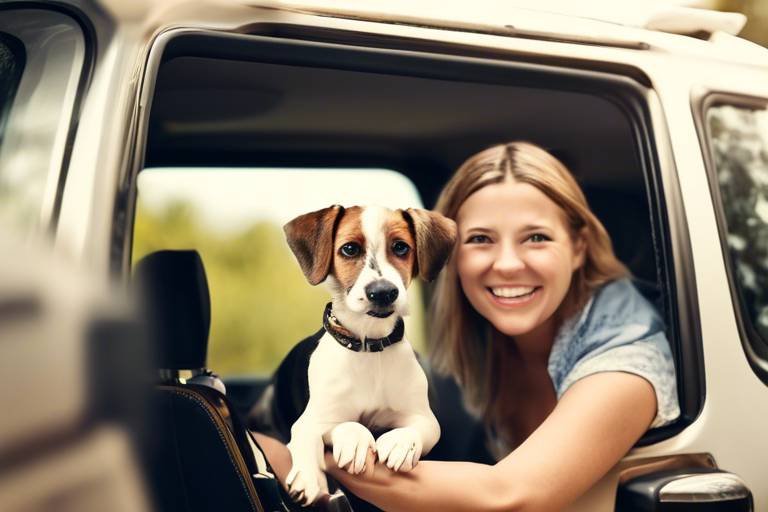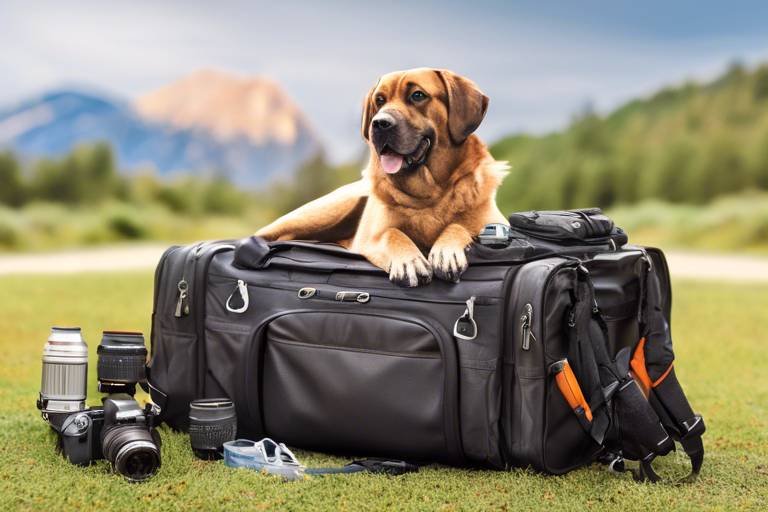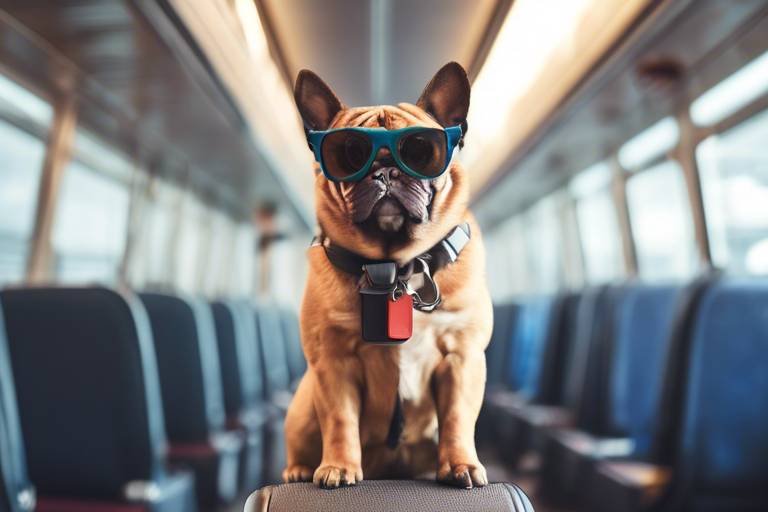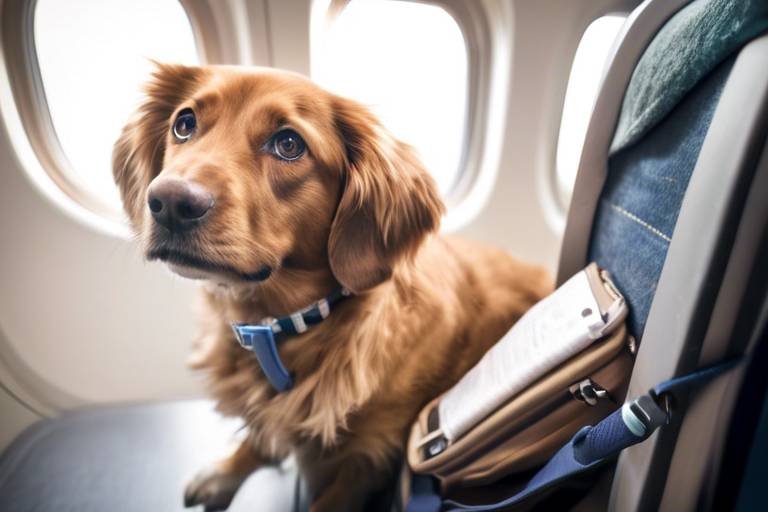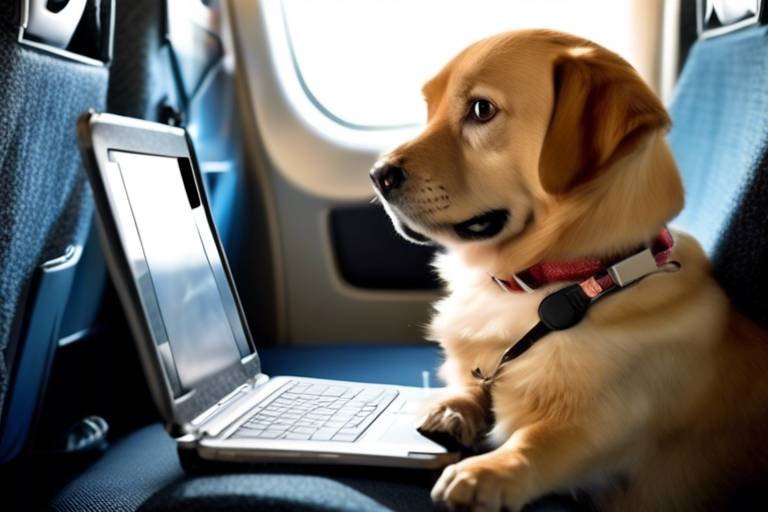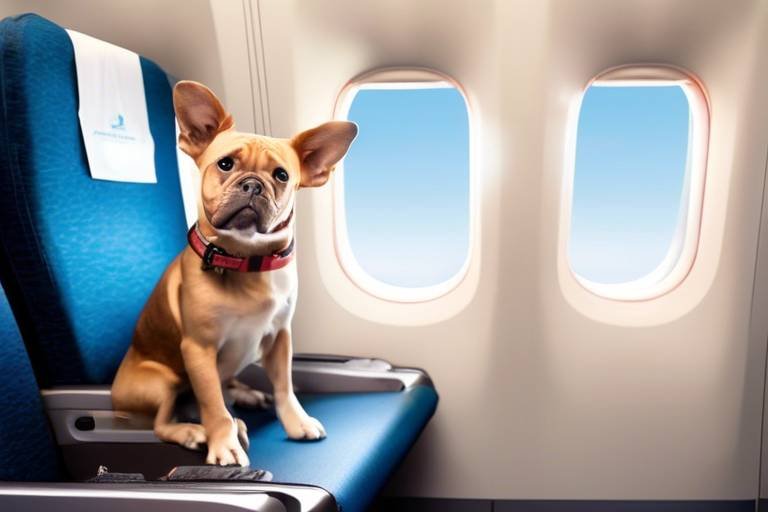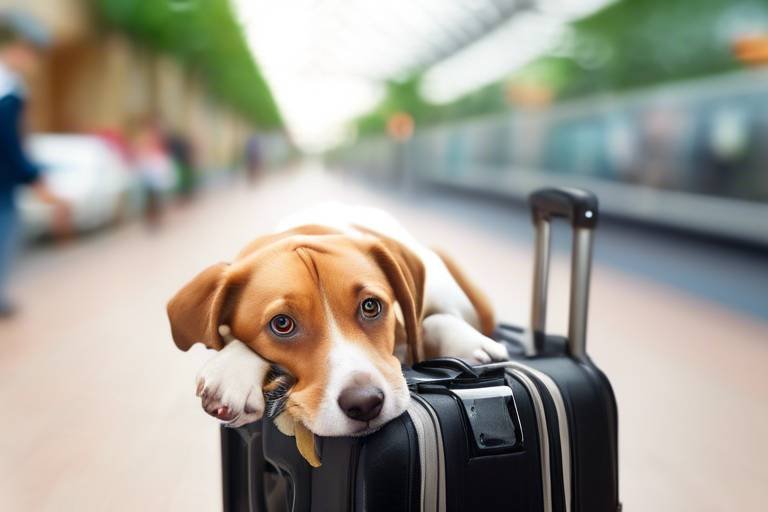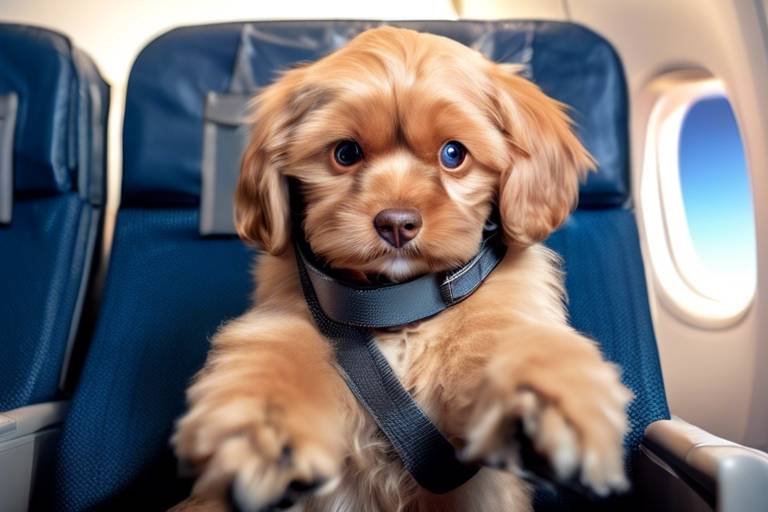How to Choose the Best Travel Style for Your Pet
Traveling with your furry friend can be an exhilarating adventure, but it also comes with its own set of challenges. As a responsible pet owner, you want to ensure that your pet is comfortable, safe, and happy throughout the journey. The key to achieving this is understanding your pet's unique needs and preferences. In this article, we will explore various travel styles for pets, helping you make informed decisions that cater to your pet's personality, the mode of transportation, and the necessary preparations for a successful trip.
Every pet has a distinct personality that significantly influences their travel preferences. For instance, some pets are naturally adventurous and thrive in new environments, while others may be timid and require a more familiar setting. Recognizing these traits can help you choose a travel style that keeps them comfortable and happy throughout the journey. Does your pet love to explore? If so, they might enjoy the excitement of a road trip or a hike in the great outdoors. On the other hand, if your pet is more of a homebody, you might want to consider travel options that allow for more downtime and familiarity.
When it comes to traveling with pets, the mode of transportation can greatly impact their experience. From cars to planes, each option has its advantages and challenges. Understanding these can help you select the best travel style for your furry companion. For example, car travel is often seen as the most flexible option, allowing for regular breaks and the ability to keep an eye on your pet. Conversely, air travel can be more stressful, requiring careful planning and adherence to airline policies. Below is a brief overview of the common modes of transportation:
| Mode of Transportation | Advantages | Challenges |
|---|---|---|
| Car | Flexible, regular breaks, familiar environment | Potential for motion sickness, distractions |
| Plane | Fast travel, long distances | Stressful, strict regulations, limited space |
| Train | Spacious, pet-friendly options | Limited routes, may require transfers |
Car travel is one of the most common ways to transport pets. Understanding how to prepare your vehicle and keep your pet secure can enhance the overall travel experience. Imagine embarking on a road trip with your dog eagerly sticking its head out the window, tongue flapping in the wind. To ensure this experience is enjoyable and safe, consider implementing some safety precautions.
Implementing safety measures, such as using pet seat belts or carriers, is crucial for protecting your pet during car rides. Not only do these precautions keep your furry friend secure, but they also minimize distractions for the driver. Additionally, always ensure that your pet is comfortable in their designated space, whether that’s a crate or a seatbelt designed for pets.
Providing comfort items like blankets, toys, and regular breaks can help reduce anxiety and make car trips more enjoyable for your pet. Think of it as creating a cozy little nest for your pet in the backseat. Frequent stops for bathroom breaks and stretching can also work wonders in keeping your pet happy and relaxed.
Flying with pets requires careful planning. Knowing airline policies and preparing your pet for the experience can make air travel less stressful for both you and your furry friend. Make sure to check the specific airline's pet policy, as they can vary significantly. Some airlines allow pets in the cabin, while others may require them to travel in the cargo hold. Understanding these nuances can save you from unexpected surprises.
Selecting an appropriate carrier is essential for your pet's safety and comfort during travel. Different types of carriers cater to various travel styles and pet sizes. A well-chosen carrier can make all the difference in how your pet experiences travel.
Understanding the differences between soft-sided and hard-sided carriers can help you choose the best option for your pet's needs and the type of travel you plan. Soft-sided carriers are often more flexible and easier to store, while hard-sided carriers provide more protection and security. Consider your pet's personality and travel style when making this decision.
Ensuring the carrier is the right size and provides adequate ventilation is vital for your pet's comfort and well-being during travel. A carrier that is too small can cause anxiety, while one that is too large won’t provide the sense of security your pet needs. The ideal carrier allows your pet to stand, turn around, and lie down comfortably.
Proper preparation can ease your pet's anxiety and ensure a smooth travel experience. Familiarizing them with the carrier and practicing short trips can help them adjust. Think of it as a dress rehearsal for the big show!
Before traveling, a health check-up and ensuring all necessary documentation are in order can prevent complications and ensure your pet is fit for travel. This includes vaccinations, health certificates, and any other paperwork required by airlines or hotels. It’s always better to be safe than sorry!
Gradually introducing your pet to travel experiences can help reduce stress and make them more comfortable with the journey ahead. Start with short car rides and gradually increase the duration. This way, your pet will learn that travel can be a fun and rewarding experience.
- What should I do if my pet gets anxious during travel? Consider using calming aids or consult your veterinarian for advice.
- Can I take my pet on a plane? Yes, but check the airline's pet policy beforehand.
- How do I prepare my pet for a long car trip? Ensure they are comfortable, take regular breaks, and keep them entertained with toys.

Understanding Your Pet's Personality
Every pet, whether it's a playful puppy or a wise old cat, has a unique personality that plays a significant role in how they experience travel. Understanding your pet's personality is crucial because it helps you tailor your travel plans to suit their needs, ensuring a smoother journey for both of you. For instance, some pets are naturally adventurous and love exploring new environments, while others may be more timid and prefer the comfort of familiar surroundings.
To get a better grasp of your pet's personality, consider the following traits:
- Curiosity: Does your pet love to sniff around and investigate new places? If so, they might enjoy road trips or visits to pet-friendly parks.
- Social Behavior: Is your pet friendly with other animals and people? A sociable pet may thrive in bustling environments, while a more reserved one might feel overwhelmed.
- Adaptability: How well does your pet handle change? A highly adaptable pet can cope with new experiences like hotel stays or different routines, whereas a less adaptable pet might require a more predictable travel plan.
Recognizing these traits can help you make informed decisions about your travel style. For example, if your dog is a social butterfly, you might opt for pet-friendly accommodations where they can meet new friends. Conversely, if your cat is more on the shy side, a quiet cabin retreat might be a better option. Additionally, understanding your pet's comfort levels can guide you in choosing the right mode of transportation, whether it's a cozy car ride or a flight. Remember, the goal is to create a travel experience that is not only enjoyable for you but also stress-free for your furry companion.
Furthermore, don’t forget that your pet’s personality can change over time. A once adventurous pup might become more cautious as they age. Regularly reassessing your pet’s comfort with travel will ensure that you’re always on the same page, making adjustments to your travel plans as necessary. After all, keeping your pet happy is the key to a successful trip!
Q1: How can I tell if my pet is anxious about traveling?
A1: Signs of anxiety in pets can include excessive barking, whining, pacing, or hiding. If your pet exhibits these behaviors, it might be time to reassess your travel plans or provide additional comfort items.
Q2: Should I take my pet on vacation with me?
A2: It depends on your pet's personality and comfort level. Some pets thrive on new experiences, while others may prefer to stay at home. Always consider their needs first.
Q3: How can I prepare my pet for a long car ride?
A3: Gradually acclimate your pet to longer car rides, starting with short trips. Bring along their favorite toys and blankets for comfort, and make frequent stops for breaks.

Different Modes of Transportation
When it comes to traveling with your beloved pet, the choice of transportation can significantly impact their comfort and safety. With various options available, it's essential to consider what best suits your furry friend’s personality and needs. Whether you're hitting the open road, soaring through the skies, or taking a leisurely train ride, each mode of transportation has its own set of advantages and challenges. Understanding these can help you make an informed decision that ensures a pleasant journey for both you and your pet.
First off, let’s talk about car travel. It’s often the most straightforward and flexible option, allowing you to stop whenever necessary for bathroom breaks or to stretch your pet's legs. Most pets feel more secure in a familiar environment, and your car can provide that sense of safety. However, it’s crucial to keep your pet secure during the ride. Using a pet seat belt or a carrier can prevent distractions and injuries in case of sudden stops. You wouldn’t want your furry friend to become a projectile during a quick brake, right?
Next, we have air travel, which can be a bit more complex. Airlines have specific policies regarding pet travel, and understanding these rules is vital. Some airlines allow pets in the cabin, while others may require them to travel in the cargo hold. Each option has its pros and cons, so it’s essential to prepare your pet for the experience. If your pet is small enough to fly with you, this can be a great way to keep them close and calm. On the other hand, larger pets may need extra preparation for cargo travel, including acclimating them to their carrier and ensuring they have all necessary documentation.
Train travel is another option that many pet owners overlook. Some train services are pet-friendly and allow you to bring your furry companion along for the ride. This can be a fantastic way to enjoy the journey together, especially if you’re traveling through beautiful landscapes. However, it’s essential to check the specific regulations of the train service you plan to use, as policies can vary widely.
Now, let’s not forget about buses! While not as common as cars or planes, some bus companies allow pets, particularly smaller ones. Traveling by bus can be economical and convenient, but similar to train travel, you must be aware of the bus company’s pet policies. It’s worth noting that not all buses are pet-friendly, so always check before booking your ticket.
In summary, choosing the right mode of transportation for your pet involves understanding their unique needs and preferences. Whether you opt for a car, plane, train, or bus, ensuring your pet's comfort and safety should be your top priority. Take the time to research each option, and don’t hesitate to ask for advice from fellow pet owners or professionals. After all, a happy pet makes for a happy trip!
- Can I take my pet on a plane? Yes, but you need to check the airline's pet policy and make the necessary preparations.
- Is car travel safe for pets? Absolutely! Just ensure they are secured with a pet seat belt or in a carrier.
- What should I do if my pet gets anxious during travel? Consider calming products or consult your vet for advice on anxiety management.
Traveling by Car
When it comes to , it’s often the most convenient and comfortable option for both you and your furry friend. Imagine the open road ahead, the wind in your hair, and your pet happily gazing out the window. However, before you hit the highway, it’s essential to prepare adequately. This means not just packing your bags, but also ensuring your pet is ready for the journey. After all, a smooth ride can make all the difference in keeping your pet relaxed and content.
First things first, you’ll want to think about your pet's comfort and safety. Securing your pet in the vehicle is crucial. Did you know that unrestrained pets can become dangerous projectiles in the event of a sudden stop? That’s why using a pet seat belt or a secure carrier is non-negotiable. A well-fitted harness or a sturdy carrier can prevent injury and keep your pet calm during the ride. You wouldn't want your beloved companion to feel like they're on a roller coaster, would you?
Now, let’s talk about making those car rides as enjoyable as possible. Think about bringing along some of your pet’s favorite comfort items, such as a cozy blanket or a beloved toy. These familiar scents can help ease anxiety and create a sense of security. Additionally, planning regular breaks during longer trips is essential. Stopping every couple of hours allows your pet to stretch their legs, relieve themselves, and hydrate. It’s like a mini adventure for them, breaking up the monotony of the journey.
It’s also wise to prepare for the unexpected. Having a travel kit for your pet can be a lifesaver. This kit could include:
- Food and water bowls
- Enough food for the trip
- Leash and waste bags
- First aid supplies
- Any medications your pet may need
Remember, the goal is to keep your pet happy and stress-free. Consider using calming aids, like pheromone sprays or anxiety wraps, if your pet tends to get anxious during travel. And don’t forget to keep the car at a comfortable temperature. Pets can’t cool off as easily as we do, so make sure it’s not too hot or too cold.
In summary, traveling by car can be a delightful experience for both you and your pet if you take the time to prepare. By ensuring their safety, providing comfort items, and planning for breaks, you can create a fantastic journey full of memorable moments. So buckle up, roll down the windows, and enjoy the ride together!
Here are some common questions pet owners have about traveling by car:
- How can I keep my pet calm during long car rides? Consider using calming aids, taking regular breaks, and bringing familiar items.
- Is it safe to let my pet stick their head out the window? No, it can be dangerous and lead to injuries.
- What should I do if my pet gets car sick? Consult your veterinarian for advice on managing motion sickness.
Safety Precautions for Car Travel
When it comes to traveling by car with your furry friend, safety should always be the top priority. Just like you wouldn’t drive without wearing a seatbelt, your pet needs protection too! One of the best ways to ensure your pet's safety is by using a pet seat belt or a secure carrier. These devices prevent your pet from roaming around the vehicle, which can be distracting and dangerous. Imagine your dog jumping into your lap while you’re trying to make a sharp turn—yikes! Keeping them restrained not only protects them but also keeps you focused on the road.
Moreover, it’s crucial to choose the right type of carrier based on your pet's size and temperament. A carrier that’s too small will make your pet uncomfortable, while one that’s too big may not provide the necessary restraint. Look for carriers that are well-ventilated and easy to secure in your vehicle. If you’re unsure, consult with your vet or a pet specialist to find the perfect fit.
In addition to using a carrier or seat belt, consider the following safety tips:
- Never leave your pet alone in a parked car: Temperatures can rise quickly, putting your pet at risk of heatstroke.
- Keep windows partially closed: This allows for ventilation while preventing your pet from jumping out or getting injured.
- Plan for breaks: Schedule regular stops for bathroom breaks and to let your pet stretch their legs. This helps reduce anxiety and keeps them comfortable.
Lastly, always have a pet emergency kit in your car. This kit should include items like water, food, a leash, waste bags, and any medications your pet may need. Having these essentials on hand can make a world of difference in case of unexpected situations during your travels. Remember, a little preparation goes a long way in ensuring a safe and enjoyable journey for both you and your beloved pet!
Q: Can I let my pet roam freely in the car?
A: No, it’s not safe. Your pet should be secured in a carrier or with a pet seat belt to prevent distractions and injuries.
Q: What should I do if my pet gets anxious during car rides?
A: Gradually acclimate your pet to car travel with short trips, and consider using calming products or consulting your vet for advice.
Q: How often should I take breaks during long drives?
A: Aim for a break every 2-3 hours to allow your pet to relieve themselves and stretch their legs.
Making Car Rides Comfortable
When it comes to ensuring your pet enjoys car rides, comfort is key. Imagine being stuck in a confined space for hours without the ability to stretch or move around; it sounds dreadful, right? That’s exactly how your furry friend might feel if you don’t take the necessary steps to make their travel experience pleasant. Start by creating a cozy environment in your vehicle. Consider bringing along their favorite blanket or toy. Familiar scents can work wonders in calming anxious pets, making them feel more at home even on the road.
Additionally, regular breaks are essential for both you and your pet. Just like humans, pets need to stretch their legs and relieve themselves. Plan to stop every couple of hours to allow your pet to get out, explore, and refresh. During these breaks, take the time to hydrate your pet and offer a light snack if it’s appropriate. This not only helps in keeping their energy levels up but also reduces the likelihood of motion sickness, which can be a common concern during long trips.
Another great tip is to use a pet seat cover or blanket over your car seats. This not only keeps your car clean but also provides a comfortable space for your pet to sit on. Some pets may feel more secure if they have a designated spot that feels familiar. If your pet is prone to anxiety, consider using calming sprays or anxiety wraps designed for pets, which can help soothe their nerves during the journey.
Finally, always remember to secure your pet properly. Whether you choose a pet seat belt or a carrier, ensuring they are safely restrained will not only protect them in the event of sudden stops but also prevent distractions while you drive. A calm and secure pet can make the overall travel experience much more enjoyable for everyone involved. So, gear up with these tips, and you’ll be on your way to making car rides a delightful adventure for your beloved companion!
- How often should I take breaks during a long car ride? It's advisable to take breaks every 2-3 hours to allow your pet to stretch, relieve themselves, and hydrate.
- Can I give my pet medication for anxiety during travel? Consult your veterinarian to discuss appropriate options for your pet's anxiety during travel.
- What should I do if my pet gets car sick? Gradually acclimate your pet to car rides, and consult your vet for specific medications or strategies to minimize motion sickness.
Air Travel Considerations
When it comes to flying with your furry companion, the stakes can feel sky-high! Air travel can be quite the adventure, but it also requires careful planning to ensure a smooth journey for both you and your pet. First things first, it's essential to check the airline's pet policy before booking your flight. Each airline has its own rules regarding pet travel, including size restrictions, carrier specifications, and additional fees. Some airlines only allow pets in the cabin, while others may require them to travel in the cargo hold. Understanding these policies can save you a lot of hassle and anxiety later on.
Once you’ve selected an airline that suits your needs, it’s time to prepare your pet for the experience. Start by familiarizing your pet with their carrier. Let them explore it at home, and consider using treats or toys to create positive associations. This way, when the big day arrives, your pet will feel more at ease in their travel space. Practice makes perfect! If possible, take your pet on short car trips or even train rides to help them adjust to being in a confined space.
Another crucial aspect of air travel is ensuring your pet is healthy and well-prepared for the journey. Schedule a visit to the veterinarian for a health check-up, and make sure your pet is up-to-date on vaccinations. Many airlines require a health certificate issued by a vet, typically within a certain timeframe before travel. This document confirms that your pet is fit to fly and free from contagious diseases. Don’t forget to pack any necessary medications as well, along with a few comfort items like a favorite blanket or toy to help soothe your pet during the flight.
As you prepare for your flight, it's also vital to consider the timing of your travel. Try to book direct flights whenever possible to minimize stress. Layovers can be overwhelming for pets, especially if they have to change carriers or wait in unfamiliar environments. If your pet is traveling in the cargo hold, aim for early morning or late evening flights when temperatures are cooler. This can help ensure your pet's safety and comfort during the journey.
Lastly, be sure to arrive at the airport with plenty of time to spare. Navigating security and boarding can take longer than expected, especially when you have a pet in tow. Allow yourself extra time to check in and get through security without feeling rushed. Remember, a calm and collected pet parent leads to a calmer pet!
- What should I do if my pet is anxious about flying? Consider using calming products like pheromone sprays or consult your vet about anxiety medications.
- Can I take my pet out of the carrier during the flight? Generally, pets must remain in their carriers for the entire duration of the flight, but you can check with the airline for specific policies.
- What if my pet gets sick during the flight? Always carry a basic first-aid kit for pets, and inform the flight attendants if your pet shows signs of distress.

Choosing the Right Pet Carrier
When planning a trip with your furry companion, one of the most critical decisions you'll make is selecting the right pet carrier. This choice can significantly impact your pet's comfort, safety, and overall travel experience. With a plethora of options available, it can feel overwhelming, but understanding the various types of carriers and their features will help you make an informed decision. Think of your pet's carrier as their personal little sanctuary on the road or in the air—a cozy space where they can feel secure and at ease.
First and foremost, consider your pet's size and behavior. For small dogs or cats, a soft-sided carrier might be perfect, as it provides flexibility and comfort. On the other hand, larger breeds or more active pets might require a hard-sided carrier, which offers durability and stability. It's like choosing between a comfy sofa and a sturdy chair; each has its purpose, and the right choice depends on your pet's personality and needs.
Another essential factor is the carrier's ventilation. A well-ventilated carrier ensures that your pet has enough fresh air during travel, which is crucial for their comfort and health. Look for carriers with mesh panels or multiple air holes. Remember, just like us, pets can feel claustrophobic in tight spaces, so providing them with adequate airflow is vital. Additionally, you should ensure that the carrier is spacious enough for your pet to stand, turn around, and lie down comfortably. This is crucial for longer trips where they may need to stretch out.
When it comes to selecting a carrier, don't forget about ease of use. A carrier that is easy to open and close will save you a lot of hassle, especially when you're in a rush or dealing with a restless pet. Some carriers come with features like top-loading openings, which can make it easier to place your pet inside without the stress of maneuvering them through a narrow entrance. Think of it as choosing a bag with a wide opening versus one with a small zipper; convenience can make all the difference during travel.
Lastly, always check the airline regulations if you're flying. Different airlines have specific requirements regarding pet carriers, including dimensions, materials, and even the type of locking mechanisms. You wouldn’t want to get to the airport only to find out your carrier doesn’t meet their standards. A little research can save you from a lot of last-minute stress!
In summary, choosing the right pet carrier involves considering your pet's size, behavior, ventilation needs, ease of use, and travel regulations. By taking these factors into account, you can ensure that your pet travels comfortably and safely, making the journey enjoyable for both of you.
- What size carrier do I need for my pet? The carrier should be large enough for your pet to stand, turn around, and lie down comfortably.
- Are soft-sided carriers better than hard-sided ones? It depends on your pet's needs and the type of travel. Soft-sided carriers are often more flexible, while hard-sided carriers provide more stability.
- How can I acclimate my pet to the carrier? Start by allowing your pet to explore the carrier at home, then gradually take them on short trips to help them get used to it.
- Do I need to buy a new carrier for air travel? Check with your airline for their specific requirements, as they may have size and safety regulations that your current carrier does not meet.
Soft-Sided vs. Hard-Sided Carriers
When it comes to transporting your furry friend, choosing between soft-sided and hard-sided carriers can feel like a daunting task. Each type has its own set of advantages and disadvantages, and understanding these can help you make the best decision for your pet's comfort and safety during travel. Soft-sided carriers are often lightweight and flexible, making them easier to stow under airplane seats or in car trunks. They usually come with mesh panels for ventilation, allowing your pet to see out and feel less confined. However, they may not provide the same level of protection as hard-sided carriers, particularly in the event of an accident.
On the other hand, hard-sided carriers are typically more durable and offer better protection, especially for larger pets. They can withstand rough handling and provide a secure environment for your pet. However, they can be bulkier and less convenient to carry around, especially if you're navigating busy airports or train stations. To help you weigh your options, here's a quick comparison table:
| Feature | Soft-Sided Carriers | Hard-Sided Carriers |
|---|---|---|
| Weight | Lightweight | Heavier |
| Durability | Less durable | Highly durable |
| Flexibility | Flexible and collapsible | Rigid |
| Ventilation | Good ventilation with mesh | Limited ventilation, usually small openings |
| Comfort | Cozy for pets | More secure but less cozy |
Choosing the right carrier isn't just about personal preference; it’s essential to consider your pet’s size, behavior, and the type of travel you plan to undertake. For instance, if your pet is a nervous traveler, a soft-sided carrier might offer them a sense of security, while a more adventurous pet might feel safer in a hard-sided carrier. Additionally, many airlines have specific regulations regarding carrier types, so it’s wise to check those guidelines before making a final decision.
Ultimately, the best carrier for your pet is one that meets their needs while complying with travel regulations. Take the time to observe your pet's behavior in different carriers, and don’t hesitate to try out both options before committing. After all, a happy pet makes for a happy journey!
- What size carrier do I need for my pet? It depends on your pet's size. They should be able to stand, turn around, and lie down comfortably.
- Are soft-sided carriers allowed on airplanes? Most airlines accept soft-sided carriers, but check specific airline policies for size and type.
- Can I use a hard-sided carrier for car travel? Yes, hard-sided carriers are safe for car travel but ensure they are secured properly.
- How do I acclimate my pet to a new carrier? Start by letting your pet explore the carrier at home, gradually introducing them to it with treats and short trips.
Carrier Size and Comfort
When it comes to traveling with your furry friend, are paramount. Imagine cramming yourself into a tiny suitcase for hours on end—unpleasant, right? Your pet deserves better. The right carrier should not only fit your pet snugly but also allow them to move comfortably. A carrier that is too small can lead to anxiety and discomfort, while one that is too large may not provide the sense of security your pet needs during travel.
First, let’s talk about sizing. To determine the appropriate carrier size, measure your pet from the tip of their nose to the base of their tail, and add a few inches for comfort. Ideally, your pet should be able to stand up, turn around, and lie down comfortably inside the carrier. Here’s a quick reference table to help you choose the right size:
| Pet Weight | Carrier Size |
|---|---|
| Up to 10 lbs | Small (18" x 12" x 10") |
| 10 - 20 lbs | Medium (24" x 16" x 14") |
| 20 - 30 lbs | Large (30" x 20" x 19") |
| 30 - 50 lbs | X-Large (36" x 24" x 28") |
Besides size, comfort features are crucial. Look for carriers that have adequate ventilation, soft padding, and easy access. A well-ventilated carrier ensures that your pet has enough airflow, which is especially important during long trips. Soft padding not only provides comfort but also reduces the chances of injury during transit. Additionally, carriers with multiple entry points can make it easier for your pet to get in and out, which is a big plus when traveling.
Don’t forget about the materials used in the carrier. Opt for durable yet lightweight materials that can withstand the rigors of travel. Some carriers even come with removable and washable liners, making it easy to keep everything clean and fresh. This is particularly important if your pet tends to get car sick or has accidents during travel.
Lastly, consider your pet's individual preferences. Some pets may prefer a cozy, enclosed space, while others might feel more secure in a more open design. You know your pet best, so think about their personality when making your choice. A little extra thought into the carrier can make a world of difference in how they handle the travel experience.
- What size carrier do I need for my pet? Measure your pet and refer to the sizing chart above to find the appropriate carrier size.
- How can I make my pet comfortable in the carrier? Use soft padding, familiar blankets, and ensure adequate ventilation.
- Are soft-sided carriers better than hard-sided ones? It depends on your pet’s needs and travel plans. Soft-sided carriers are often more flexible, while hard-sided ones provide more protection.

Preparing Your Pet for Travel
Traveling with your furry friend can be an exciting adventure, but it requires a bit of preparation to ensure that your pet is comfortable and stress-free. Just like you wouldn’t head out on a road trip without packing your essentials, your pet also needs some special attention before the journey begins. Think of it as packing a suitcase for your pet, filled with everything they might need to feel at home, even when you’re miles away. So, what should you do to get your pet ready for travel?
First off, familiarization is key. If your pet has never been in a carrier or a car, they might feel anxious or scared. Start by allowing them to explore their carrier at home. Leave it open in a cozy spot and toss in some of their favorite toys or a soft blanket. This will help them associate the carrier with comfort rather than confinement. You can also take them on short car rides to help them get used to the motion and sounds of travel. Gradually increasing the duration of these trips will help your pet acclimate to longer journeys.
Next, it’s crucial to schedule a health check-up with your veterinarian before any travel plans. This step is not just about ensuring your pet is fit to travel; it’s also about making sure you have all the necessary documentation. Some airlines and hotels require proof of vaccinations or health certificates, so having these documents in order can save you a lot of hassle later. Your vet can also provide advice on how to manage travel anxiety, whether that means medication or simply tips for keeping your pet calm.
When it comes to packing for your pet, consider including the following items in your travel kit:
- Food and water bowls
- Enough food for the duration of the trip, plus some extra
- A leash and collar with an ID tag
- Medications, if any
- Comfort items, like a favorite toy or blanket
Finally, it’s important to think about your pet's comfort during the journey. Just like you would want a comfy seat and snacks for a long trip, your pet deserves the same. Make sure the carrier is well-ventilated and that your pet has enough space to sit, stand, and turn around comfortably. During breaks, allow your pet to stretch their legs and relieve themselves. This not only makes the journey more enjoyable for them but also helps to reduce anxiety.
| Question | Answer |
|---|---|
| How can I reduce my pet's travel anxiety? | Familiarize them with their carrier, take short trips, and consider calming products or medications from your vet. |
| What documents do I need for traveling with my pet? | A health certificate, vaccination records, and any other specific documentation required by airlines or hotels. |
| Is it safe to travel with my pet during extreme weather? | It's best to avoid traveling in extreme heat or cold. If you must travel, ensure your pet is comfortable and safe. |
Health Check and Documentation
Before embarking on any travel adventure with your furry friend, prioritizing their health is key to ensuring a smooth journey. Just like we wouldn't set off on a long road trip without making sure our car is in good shape, the same goes for our pets! Schedule a visit to the veterinarian to get a comprehensive health check-up. This check-up should include a thorough examination to confirm that your pet is fit for travel, as well as any necessary vaccinations. Some destinations may require specific vaccinations, so be sure to consult with your vet about the requirements.
In addition to a health check, it's essential to gather all necessary documentation. This includes vaccination records, health certificates, and any relevant medical history. These documents not only ensure your pet's safety but also help avoid any unexpected issues at borders or during flights. You wouldn’t want to be stuck in a situation where you can’t prove your pet is healthy!
Here’s a quick rundown of what you might need:
- Vaccination Records: Proof of vaccinations, especially for rabies.
- Health Certificate: A document from your vet stating your pet is healthy and fit for travel.
- Microchip Information: If your pet is microchipped, keep that information handy in case they get lost.
- Emergency Contacts: Have a list of emergency contacts, including your vet's number and a local vet at your destination.
By ensuring all documentation is in order and your pet is healthy, you can significantly reduce travel-related stress. It’s like having a safety net that allows you to focus on enjoying the journey rather than worrying about what might go wrong. Remember, a little preparation goes a long way in keeping your beloved pet safe and happy during your travels!
- What vaccinations does my pet need before traveling? It varies by destination, but rabies is commonly required. Check with your vet.
- How long before travel should I take my pet for a health check? Ideally, schedule the appointment at least a few weeks prior to your trip.
- Do I need a health certificate for air travel? Yes, most airlines require a health certificate issued by a veterinarian.
- What should I do if my pet gets anxious during travel? Consider consulting your vet about calming aids or strategies to ease their anxiety.
Acclimating Your Pet to Travel
Traveling can be an exciting adventure, but for our furry friends, it can sometimes feel overwhelming. Just like us, pets can experience anxiety when faced with new environments and experiences. That's why is essential to ensure a smooth journey. So, how do you go about it? It’s all about gradual exposure and positive reinforcement!
Start by introducing your pet to their travel carrier well in advance of your trip. Leave the carrier open in a familiar space at home, allowing your pet to explore it at their own pace. You might find your dog or cat sniffing around, or even curling up inside for a nap—this is a great sign! To make the carrier more inviting, consider placing their favorite blanket or a few toys inside. This will help them associate the carrier with comfort and safety.
Next, consider taking your pet on short car trips around the neighborhood. This not only helps them get used to the motion of the vehicle but also exposes them to the sounds and smells they might encounter during longer journeys. Start with short rides, gradually increasing the distance as your pet becomes more comfortable. Always reward them with treats and praise after each trip, reinforcing positive behavior. Think of it as a mini-adventure!
For pets that will be flying, it’s crucial to familiarize them with the sounds and sensations of air travel. You can achieve this by playing recordings of airplane sounds at a low volume while they enjoy their favorite activities at home. This will help desensitize them to the noises they will encounter in the airport or on the plane. Additionally, practice having them stay in their carrier for longer periods while you're at home, gradually increasing the time as they adjust.
Don’t forget to schedule a visit to the vet before embarking on your journey. A health check-up ensures your pet is fit for travel and allows you to obtain any necessary documentation. This is also a good time to discuss any concerns you may have about your pet's behavior during travel. Your vet can provide tips tailored to your pet's specific needs and may even recommend calming supplements if your pet is particularly anxious.
Lastly, it's essential to monitor your pet's behavior throughout this acclimation process. If they show signs of stress or discomfort, take a step back and give them more time to adjust. Every pet is unique, and what works for one may not work for another. Remember, the goal is to make travel a positive experience for both you and your pet!
- How long should I acclimate my pet to travel? It's best to start the acclimation process several weeks before your trip, gradually increasing exposure to travel-related experiences.
- What should I do if my pet is still anxious during travel? If your pet shows signs of anxiety, consider consulting your veterinarian for advice on calming techniques or medications.
- Can I use treats to help with acclimation? Absolutely! Using treats as rewards during the acclimation process can reinforce positive behavior and help your pet feel more comfortable.
- Is it safe to travel with my pet during the pandemic? Always check the latest travel guidelines and restrictions related to COVID-19, as they can vary by location and may affect pet travel.
Frequently Asked Questions
- What is the best travel style for my pet?
The best travel style for your pet depends on their personality, comfort needs, and the mode of transportation. For example, some pets may feel more secure in a car, while others might adapt well to air travel. Understanding your pet’s traits is key to making the right choice.
- How can I prepare my pet for a car trip?
Preparing your pet for a car trip involves several steps: ensure they are comfortable in a secure carrier or with a pet seat belt, bring familiar items like blankets or toys, and plan for regular breaks to allow them to stretch and relieve themselves. This will help reduce anxiety and make the ride more enjoyable.
- Are there specific airline policies I should know about?
Yes, each airline has its own pet travel policies, including carrier size requirements, fees, and rules for in-cabin versus cargo travel. It's essential to check these details well in advance to avoid any surprises on travel day.
- What type of pet carrier should I choose?
The choice between a soft-sided and hard-sided carrier depends on your pet's size, comfort, and the type of travel. Soft-sided carriers are often more flexible and easier to stow, while hard-sided carriers provide more protection. Always ensure the carrier is well-ventilated and the right size for your pet.
- How can I make my pet comfortable during air travel?
To ensure your pet’s comfort during air travel, acclimate them to their carrier before the trip, provide familiar items, and choose a direct flight if possible. Also, consult with your vet about any anxiety medication if your pet tends to get stressed during travel.
- What health checks should I perform before traveling?
Before traveling, it’s crucial to schedule a health check-up with your veterinarian to ensure your pet is fit for travel. Make sure all vaccinations are up-to-date and gather necessary documentation, such as health certificates, especially for air travel.
- How can I help my pet adjust to travel?
Gradually introducing your pet to travel can ease their anxiety. Start with short car rides, let them explore their carrier, and reward them with treats to create positive associations with travel. This way, they’ll feel more comfortable when it’s time for a longer journey.

